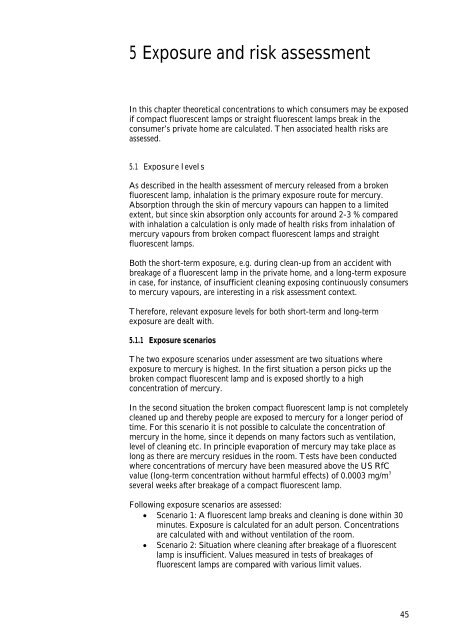No. 104 - Miljøstyrelsen
No. 104 - Miljøstyrelsen
No. 104 - Miljøstyrelsen
Create successful ePaper yourself
Turn your PDF publications into a flip-book with our unique Google optimized e-Paper software.
5 Exposure and risk assessment<br />
In this chapter theoretical concentrations to which consumers may be exposed<br />
if compact fluorescent lamps or straight fluorescent lamps break in the<br />
consumer’s private home are calculated. Then associated health risks are<br />
assessed.<br />
5.1 Exposure levels<br />
As described in the health assessment of mercury released from a broken<br />
fluorescent lamp, inhalation is the primary exposure route for mercury.<br />
Absorption through the skin of mercury vapours can happen to a limited<br />
extent, but since skin absorption only accounts for around 2-3 % compared<br />
with inhalation a calculation is only made of health risks from inhalation of<br />
mercury vapours from broken compact fluorescent lamps and straight<br />
fluorescent lamps.<br />
Both the short-term exposure, e.g. during clean-up from an accident with<br />
breakage of a fluorescent lamp in the private home, and a long-term exposure<br />
in case, for instance, of insufficient cleaning exposing continuously consumers<br />
to mercury vapours, are interesting in a risk assessment context.<br />
Therefore, relevant exposure levels for both short-term and long-term<br />
exposure are dealt with.<br />
5.1.1 Exposure scenarios<br />
The two exposure scenarios under assessment are two situations where<br />
exposure to mercury is highest. In the first situation a person picks up the<br />
broken compact fluorescent lamp and is exposed shortly to a high<br />
concentration of mercury.<br />
In the second situation the broken compact fluorescent lamp is not completely<br />
cleaned up and thereby people are exposed to mercury for a longer period of<br />
time. For this scenario it is not possible to calculate the concentration of<br />
mercury in the home, since it depends on many factors such as ventilation,<br />
level of cleaning etc. In principle evaporation of mercury may take place as<br />
long as there are mercury residues in the room. Tests have been conducted<br />
where concentrations of mercury have been measured above the US RfC<br />
value (long-term concentration without harmful effects) of 0.0003 mg/m 3<br />
several weeks after breakage of a compact fluorescent lamp.<br />
Following exposure scenarios are assessed:<br />
� Scenario 1: A fluorescent lamp breaks and cleaning is done within 30<br />
minutes. Exposure is calculated for an adult person. Concentrations<br />
are calculated with and without ventilation of the room.<br />
� Scenario 2: Situation where cleaning after breakage of a fluorescent<br />
lamp is insufficient. Values measured in tests of breakages of<br />
fluorescent lamps are compared with various limit values.<br />
45

















